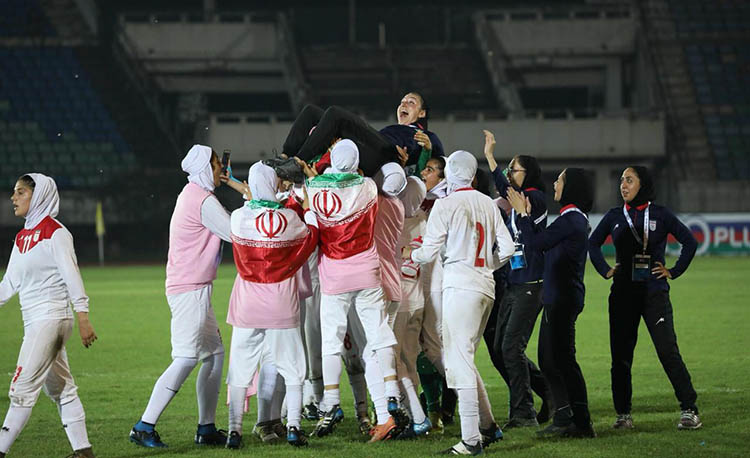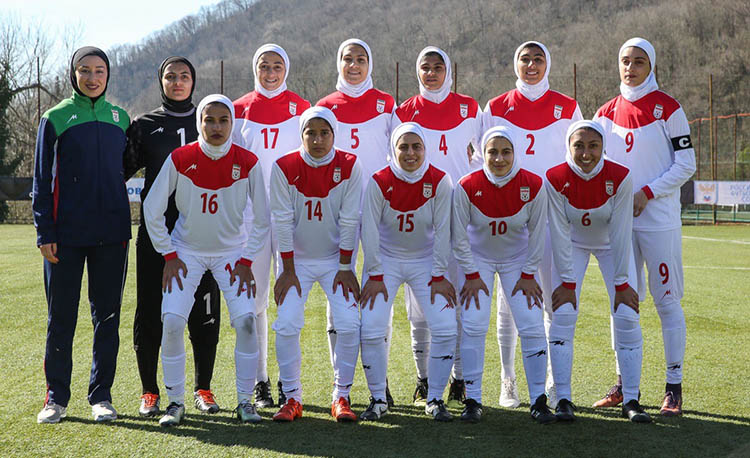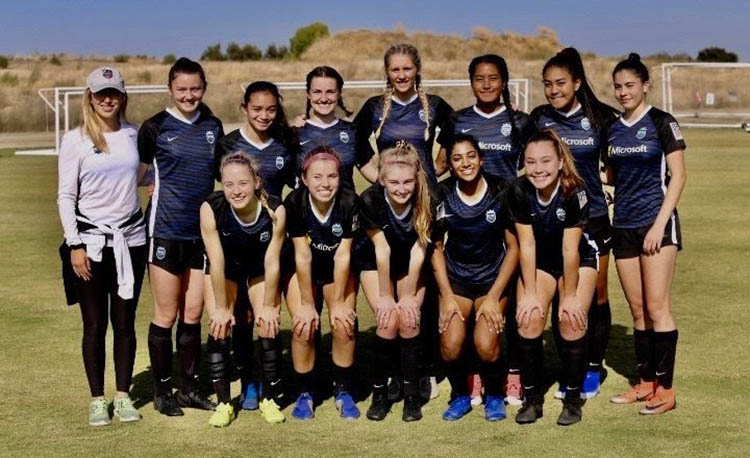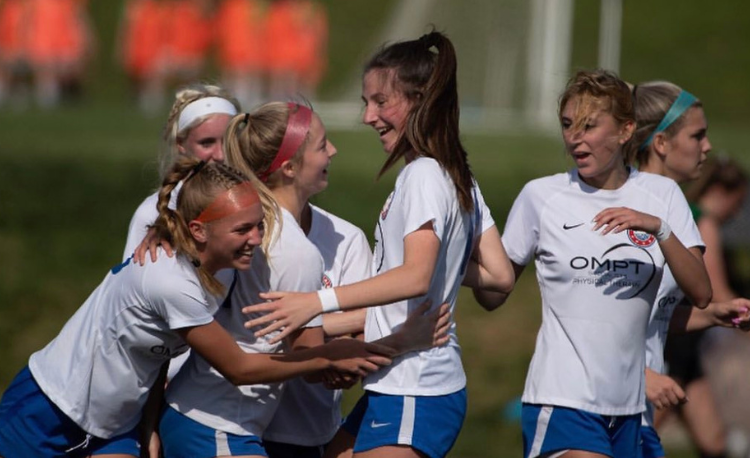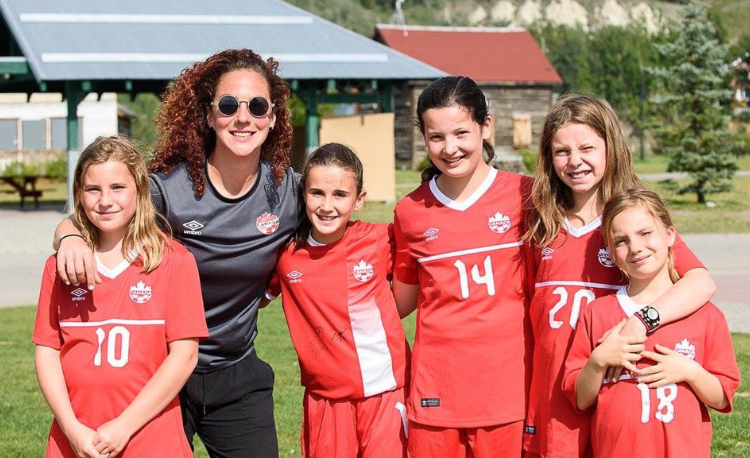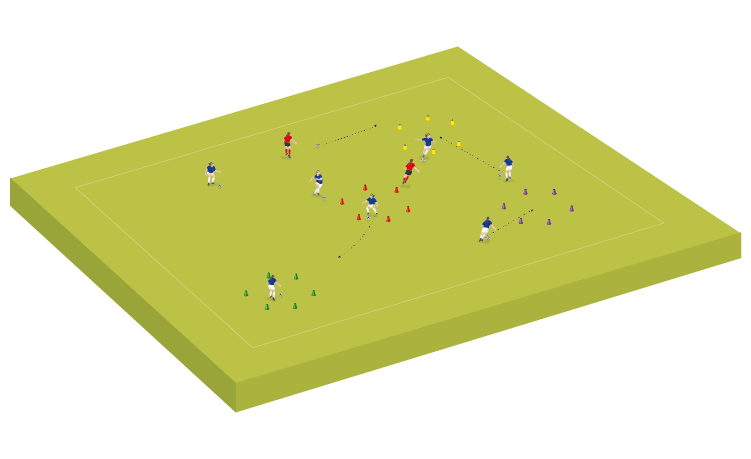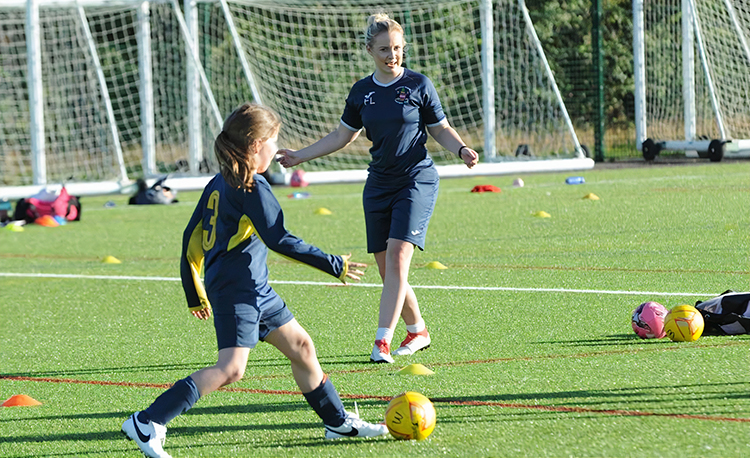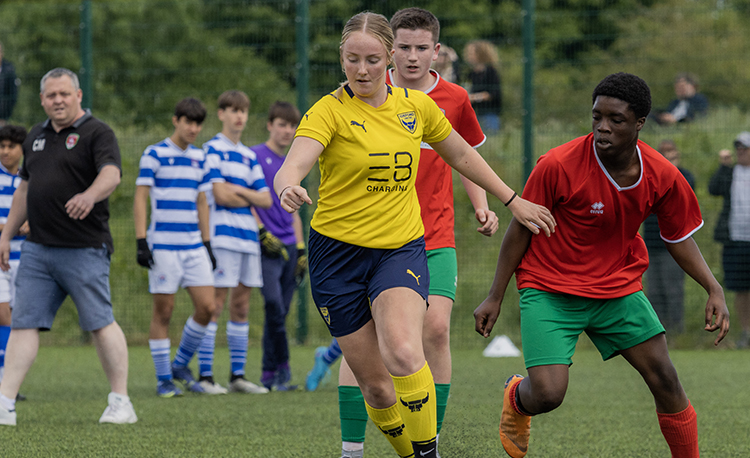You are viewing
1 of your 3 free articles
Tehran turnaround
The first Iranian woman with the A License, KAT KHOSROWYAR lobbied Fifa to allow head coverings and built the nation’s Under-17s girls’ team from scratch in just two weeks. She tells her story to STEPH FAIRBAIRN
Katayoun “Kat” Khosrowyar is studying for a Masters degree in global affairs at Rice University in Houston, Texas.
The purpose, she tells Women’s Soccer Coaching, is to “put all my skills, abilities and experience under one umbrella”. It would need to be a sizeable umbrella.
Growing up in Oklahoma, with Iranian heritage, Kat became an avid soccer player, describing the first time she touched the ball as “love at first sight”.
On a family holiday to Iran in 2005, Kat was spotted playing futsal by Shahrzad Mozafar, coach of the country’s national futsal team.
Mozafar asked Kat to be part of the new project she was working on – the first Iranian women’s national soccer team since the 1979 revolution.
Before this time, soccer had been played by women across Iran, but laws requiring all women to wear a headscarf in public meant it was no longer a possibility.
In the early 1990s, students from the Alzahra University in Tehran founded a futsal team and the formation of a national league followed.
Then, following an invite from Jordan to participate in the West Asian Football Federation Women’s
Championship, the Iranian government agreed to form a soccer team.
Kat moved to Iran aged 17 to take up the challenge, and helped Iran finished runners- up behind hosts Jordan in the championship.
The competition was, according to Mozafar, “the beginning of the road of football in my country”, a road which Kat continued on as a player until the age of 24. As captain of the team, she remembers fondly a 4-1 win over India in October 2007.
“Vietnam are very strong. We tied 1-1 and that showed the impact we had...”
“We needed four goals in beating India to make it to the Asian championships,” she said.
“We scored exactly four and I remember I was the one that assisted the final goal in the last five seconds.”
A low point was the team’s disqualification from international competition in 2011, minutes before a match, for wearing hijabs. This meant qualification for the 2012 Olympic Games in London was impossible.
Kat began the ‘Let Us Play’ campaign to demand that Fifa acknowledge women who have to wear coverings while playing. It paid off in 2014 when the governing body announced it would allow head coverings for religious reasons.
Kat quit playing aged just 24, convinced she could make more of an impact on the women’s game in other areas – including coaching.
Aged 26, she became the first woman of Iranian heritage to achieve the FIFA A License. Experiences coaching the under-14, under-16 and under-17 Iran women’s teams were followed by a stint as the under-19s national team coach.
Related Files
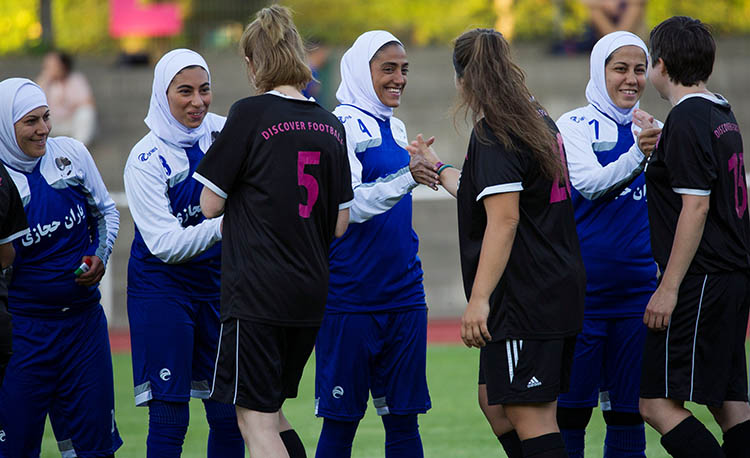
She shares two proud moments. The first: whenever they drew against Vietnam.
“Vietnam are a super small, but mighty team,” she explained. “They’re very strong, super organized and very difficult to beat. The Iranian national team had always been losing to them 5-0 or 6-0.
“With my team, whenever I was coaching, we tied them 1-1, and that showed how much of an impact and how much of a change we were able to have on these players.
“I know we didn’t win, but we definitely were able to close that gap with a very strong Asian team.”
The size of the task Kat had with the team shouldn’t be underestimated. She was, in many ways, attempting to build from scratch, to bridge the gap between a country where the progress of the women’s game had been severely halted, and others where the support and infrastructure around the game was years ahead.
The second of Kat’s proudest moments, beating Slovenia, is an indication of just how different things were.
“We went to Europe after two weeks of training the national team and we were able to win against Slovenia,” she recalls.
“They had the Nike sponsor, everything was perfect. Obviously Iranians don’t have Nike or Adidas sponsors due to the political stuff, but we played so beautifully that afterwards their coach came to me and said ‘I could never have imagined you guys can play like this’.
“To have a coach of that calibre mention something like that, for me, was nice to hear. It showed that I’m doing something right.”
She also describes her first game as head coach as an experience she will never forget.
“I was given two weeks to find a team. Some of them had never touched a football, they’d never even left the country.
“My first game was against the US. Imagine the under-17s of Iran playing against the under-17s of the US, it’s night and day.
“We lost 6-0 or 7-0, which is acceptable, because some of my players had never even played football.
“I knew if I could work with them that within six months to a year, I could definitely get what I wanted from them. But two weeks was definitely not enough time.”
So how did she go about working with them? What was she like as a head coach?
“Because of my age difference, I didn’t want to come from a very top-down approach,” she said. “I allowed them to be open with me, I wanted them to talk to me.
“I had a huge technical staff. I had so many assistant coaches. I think that was one part of my success - that as a head coach, I had to learn how to manage the coaches and the players. I had to do it separately, and know when to connect the two together.
“I had to be very, very honest with them and tell them exactly what it was like to be playing against these top teams in the world.
“But at the same time, I was continually working on them psychologically to find that inner strength to be able to play against these teams.”
“I had two weeks to find a team. Some of them had never touched a football...”
In terms of the content of her training sessions, Kat drew on the work of renowned Dutch coach Raymond Verheijen, known for his attention to detail around fitness.
Kat explains: “My training sessions were mentally very tough, but the girls enjoyed it, because I was teaching them the basics of football.
“It wasn’t just about let’s kick the ball, get it and turn past; I was teaching them how to play against the top teams.
“I know I didn’t have time, but I had to definitely find a method to be able to give them access to how to play against these top teams and give them options.
“I never was the type of coach to say ‘this is exactly what you’re going to do in this situation’. I gave them options of what to do in that certain situation.
“I was very transparent with them. We would review so many videos - I’d give them homework and they knew if they didn’t give me their answers that they would be doing something really embarrassing, like singing in the middle of the field.
“But I’m so fortunate that I was able to coach such talented young ladies.”
In 2019, Kat moved back to the US to take up an academy coach role with OL Reign. It was a reverse of the move she’d made almost 15 years earlier, and meant she was coaching in the conditions she’d grown up playing in.
Where one of her biggest challenges in Iran had been the pressure and scrutiny that comes from being watched by 80 million people, in the US she came up against a different obstacle: helicopter parents.
“THE WORLD WILL COME BACK AND GIVE YOU SO MUCH MORE”
“I think women need to support each other a lot more - whether it’s a coach from the US supporting a coach in Zanzibar, you need to be open to it.
“At the end of the day, we’re all women who love football and how much more beautiful can it be that we are able to support each other.
“Honestly, it might not be for everyone. But I think the least you can do is have a public account on your social media as a coach. Women will definitely come in and message you with their issues and hope that you will help them to solve it.
“Right now, a lot of the Afghan women’s national team have left, they are in need of access to some form of platform, especially on the coaching side.
“You are given the privilege of having all of these tools. A lot of women don’t have that privilege.
“Search a little bit. See what countries you’re interested in helping develop. Be open to it.
“I promise you, the world will come back and give you so much more.”
KAT ON THE BENEFITS OF RONDOS: “PLAYERS WILL EVENTUALLY DEVELOP AND COMPREHEND THE GAME MUCH BETTER”
“For me, rondos were a lifesaver. With the Iran national team, we had a really difficult time coming out from the back third near the sidelines, so we did that with the left and the right side.
“I would start with minimal players and then grow it and show each player what their responsibility was on the field.
“I think rondos develop players’ ability to think for themselves and be able to be more cohesive with their teammates. No matter what people do, or whatever trainings are out there, it’s always going to come back to rondos.
“I think players will eventually develop and comprehend the game much better; you’re under pressure, you have to think for yourself, you have to think what are you going to do the second you get the ball, you’re going to have to have your body position in a certain way.
“It was something that was very challenging for me to teach the girls [on the Iran national team] because they didn’t have experience playing football. But ultimately, it became the key to their success.”
“The parents are literally on the field, screaming at their daughter, screaming at me, screaming at the ref, and it’s just a really bad relationship,” Kat said.
“It’s created because everyone believes that their daughter is the best - everyone believes their daughter is number one, and they won’t let the coaches make the decisions for the benefit of the team.
“That was very difficult for me to comprehend. I had so many discussions with parents and players, saying ‘this is not healthy at all, please just stop talking during the games and stop talking to your daughters during training’.
“I think with a lot of consulting and a lot of guiding, the player can make up their own mind and stand up for themselves.”
Ultimately, it is experience from two different football cultures that has, in the same way it has moulded her coaching style, moulded her life.
I ask Kat if she is aware that many look up to her as a role model for the women’s game, particularly in emerging countries, following her work in developing Iranian soccer.
“I have been told that I’m a role model,” she replied. “But I’m just honestly trying to do what’s best for the greater amount of people, for all the women, because I was raised with privilege in the US.
“I didn’t have to fight to go play on a field. I didn’t have to fight with so many different ideological prohibitions from women playing football.”
That last remark does not just apply to Iran, but also to Afghanistan - and Kat used her contacts to help rescue players from the Afghan women’s team when the Taliban took over last year.
“My goal is to be a bigger advocate for the women’s global game,” she added.
“I want to start building these big projects, academies within developing countries, or even in developed countries, to get the talent coming, find new fun projects to do for women, and just try to get them involved as much as possible.”
Kat also wants to make sure female players and coaches know she is there if they need her. She continues to connect with female coaches across the world through courses, and lessons, and through her open DMs.
“I just want them to know that they can ask me for anything,” she adds.
“I want the coaches to know they have me to support them with their planning, or any questions they may have. I just want that gap to close as fast as possible so we can see the beautiful game being played.”
Kat’s conviction and her work to date are the proof of that sentiment. Having already achieved so much for the women’s game, she looks set to do so much more. You wouldn’t want to try stopping her.
Newsletter Sign Up
Newsletter Sign Up
Discover the simple way to become a more effective, more successful soccer coach
In a recent survey 89% of subscribers said Women's Soccer Coaching makes them more confident, 91% said Women's Soccer Coaching makes them a more effective coach and 93% said Women's Soccer Coaching makes them more inspired.
*includes 3 coaching manuals
Get Inspired
All the latest techniques and approaches
Women's Soccer Coaching offers proven and easy to use soccer drills, coaching sessions, practice plans, small-sided games, warm-ups, training tips and advice.
We've been at the cutting edge of soccer coaching since we launched Soccer Coach Weekly in 2007, creating resources for the grassroots youth coach, following best practice from around the world and insights from the professional game.
